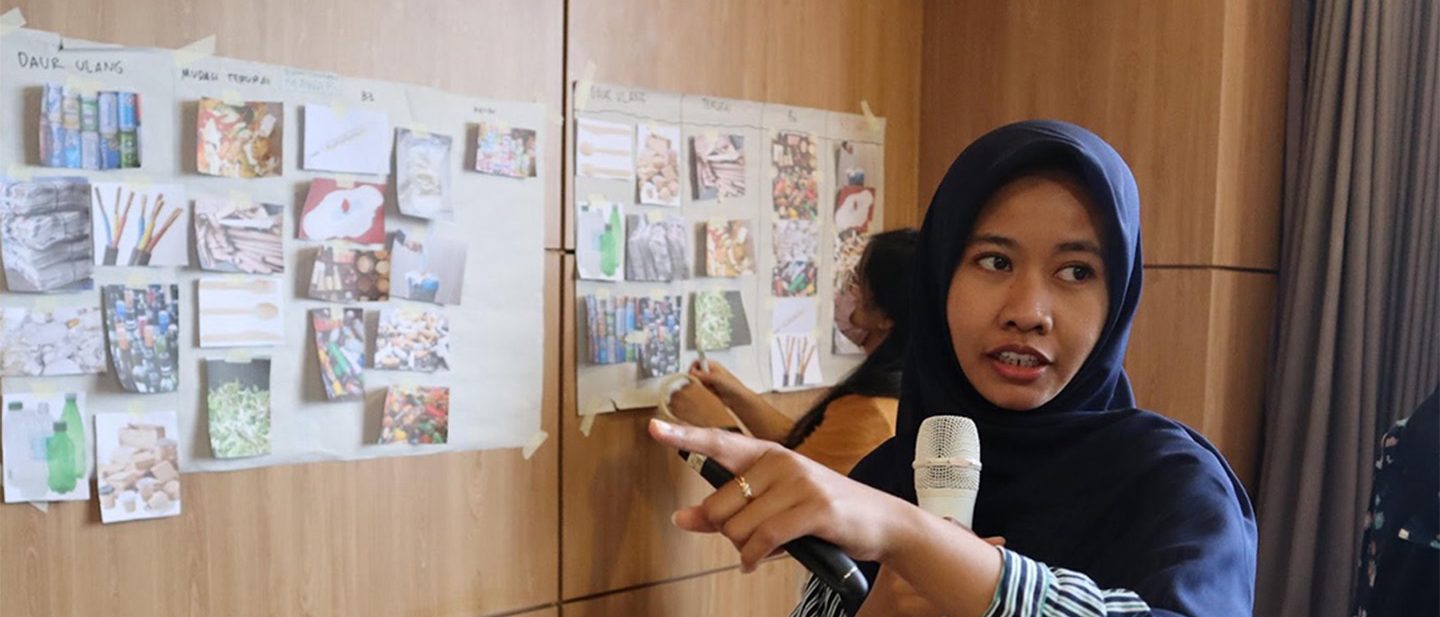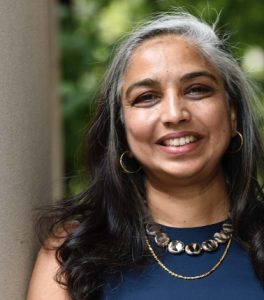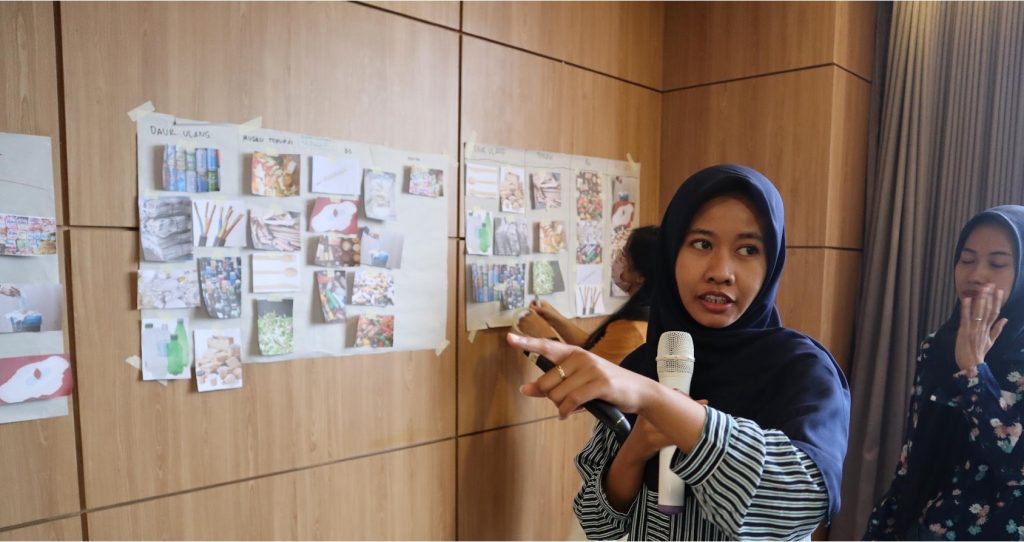
Dr. Anita Shankar is an Associate Scientist in the Department of International Health in the Division of Social and Behavioral Interventions at the Bloomberg School of Public Health. She is the Lead Investigator and Executive Director of the Self-Empowerment and Equity for Change (SEE Change) Initiative – a global training program that empowers women through gender-informed research and evidence-based training services.
One project of SEE Change involves collaboration with the Clean Cities, Blue Oceans (CCBO) program to support women waste pickers in the Philippines and Indonesia through a curriculum based on personal agency and business training.
We sat down with Dr. Shankar to learn more about her work.
Describe your background and how it led to the SEE Change Initiative.

Dr. Shankar has spent nearly 15 years living and working abroad in the international public health field. In 2010, she returned to the U.S. and decided to make a change in her approach to combating global public health issues.
“I made a major pivot in my research to understand how we can engage with populations on the ground with limited education, literacy, and resources and help them better help themselves,” says Dr. Shankar.
The best approach, she realized, was through developing programs to support individual agency (i.e. the ability to make decisions and take action) within these populations. Dr. Shankar recognized that in order for conditions to improve in any population, individual and collective empowerment (which require agency) are necessary.
Working with a variety of populations, including individuals with HIV, sex workers, and both rural and urban poor in Kenya, Dr. Shankar piloted a range of different psychosocial interventions, employing tools from cognitive science, positive psychology, and behavioral economics. According to Dr. Shankar, these disciplines were “woven together in such a way that individuals could levelset around who they were, their general thoughts processes, and how their thoughts and emotions related to their actions within the sociocultural context that they lived.”
In 2015, Dr. Shankar created the Empowered Entrepreneur Training, an open-sourced handbook that could be applied to different countries and populations. The Empowered Entrepreneur Training stemmed from a pilot randomized controlled trial in Kenya, where Dr. Shankar compared the outcomes of providing basic business training versus a behavioral training focused on building agency without business training to both female and male clean cookstove entrepreneurs. The results of the training showed that the agency-focused training led to a tripling of sales and a doubling of the longevity of the business compared with standard business training, with women selling more than men. These results suggested that agency-based empowerment training is potentially an important way to support local entrepreneurs.

Following the creation of this training, SEE Change launched in 2020 through a grant from USAID. The initiative would address two primary fields: entrepreneurship and women’s leadership in male-dominated sectors.
How did SEE Change connect with CCBO?
After living and conducting research in Indonesia for seven years, Dr. Shankar recognized an opportunity to merge the work of SEE Change with CCBO’s work in the realm of sustainability and climate. She wanted to see whether access to SEE Change’s training would improve livelihoods, waste-picking strategies, and the amount of plastic waste removed from the ocean.
“Our primary focus was to integrate personal agency into the program activities related to women’s entrepreneurship and plastic waste-picking,” says Dr. Shankar.
SEE Change’s relationship with CCBO began in Manila, Philippines. The CCBO team addressed a number of questions with Dr. Shankar and colleagues: Who were the formal and informal waste pickers? What is the larger ecosystem of waste-picking? What was the education level like for waste-pickers? Such information helped inform the BBEST program, which integrated information on best practices for plastic waste removal in waterways and landfills, plastic collection, gender-based violence awareness, with a foundation personal agency curriculum. Once the BBEST curriculum was finalized in the Philippines, Dr. Shankar and SEE Change brought the program to Semarang, Indonesia.
What communities were impacted by this program?
The funding for this project came from a larger Women’s Economic Empowerment (WEE) program associated with CCBO activities, so the program focused on women.
Within Indonesia, the WEE program focused on three groups of individuals to engage in training: informal waste-pickers, waste bank managers, and scrap dealers. The SEE Change team trained a local team to administer the training curriculum.
How do you assess progress from and results of these programs?
The program was assessed through the existing monitoring and evaluation data collection framework within the project. “The individuals that we expected to have the lowest levels of self-confidence were the informal waste-pickers,” says Dr. Shankar. “We found that they were the most likely to improve.”
In addition to improvements in agency and empowerment, Dr. Shankar and her colleagues found a net increase in the amount of kilograms of plastic waste that was removed from ocean waters. A preexisting monitoring and evaluation program tracked metrics for waste collection, but the SEE Change team added specific variables related to agency to be tracked, including: self-efficacy, environmental mastery, and self-esteem.
Dr. Shankar and colleagues assessed individual agencies by gathering data prior to training and six months after training. Such assessments included prompts such as: “I’m in charge of my financial management,” “In the last month I was able to feed my family,” “I feel like a leader in my community.”
“For all of the measures of agency and confidence that we examined, there were strong, positive changes,” says Dr. Shankar.
Sustainability and empowerment are very closely connected. What is the importance of this instilling agency and empowerment?
“The flip side of agency is anxiety, stress, and being unable to take action,” says Dr. Shankar. “At one level, this agency work is critical as an antidote to these risks for mental health.”

In addition to combating mental health struggles, strengthened resilience and agency serve as a mechanism of hope and action with which individuals can be motivated to address the climate crisis and other pressing issues of today. According to Dr. Shankar, this agency helps “to counteract the devastation impacts of what is happening to the planet.”
“[Agency is] having people recognize that sustainability is not outside of us– we are part of it,” says Dr. Shankar. “[It is] thinking about the larger ecosystem and about how we can more effectively create change and find the leadership that all of us have.”
Increased personal agency helps drive value-driven decision-making, allowing individuals to stay more informed and self-aware.
“If we are coming in a priori to change someone’s mind to follow what we think is the right thing to do, maybe that is not the best solution,” says Dr. Shankar. “The idea is to help people make the best decision by becoming more aware of what they want and taking clear actions towards those goals.”
Where is SEE Change now, given recent funding cuts and changes?
Like most international health programs, SEE Change was affected by some of the federal funding cuts. Despite these challenges, SEE Change has partnered with a range of non-federal organizations and continues to move their mission forward.
Still, the future can be uncertain. “We are going to find a way,” says Dr. Shankar. “What is not entirely clear is what that looks like, when it’s going to happen, or how it’s going to happen. But all of the people who have been striving toward creating positive and responsible change globally understand the impacts of climate and the importance of sustainable practices for humans, so that is not going to go away.”
“What it requires now is creative thinking around where we can put our efforts,” says Dr. Shankar. “What other funding sources can we draw upon? What are the technologies that we haven’t been taking advantage of that we could make things more efficient? It is a great opportunity to reset, innovate, and figure out how we move forward.”
